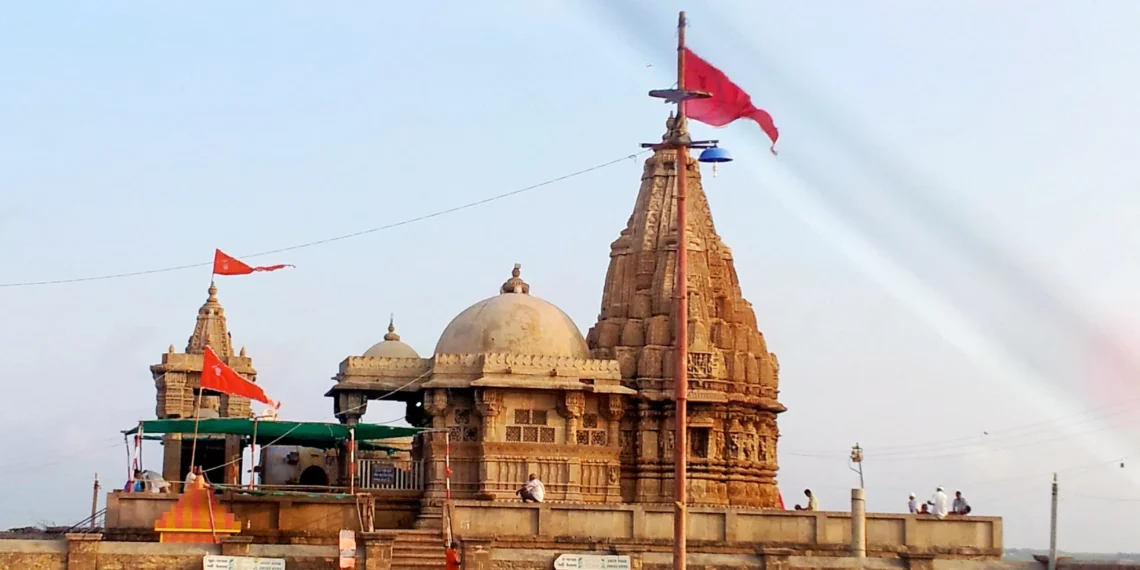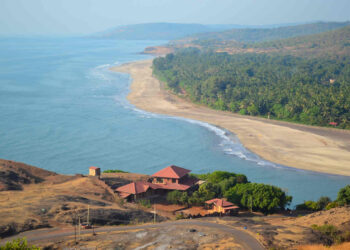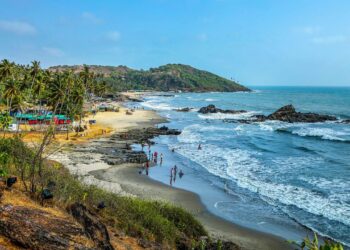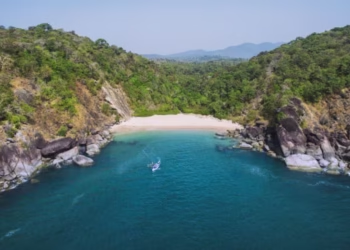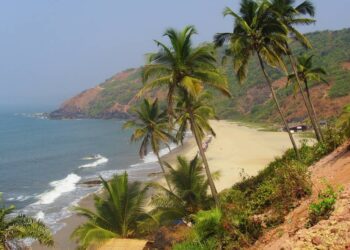Set by the calm Gomti River, a short way from Dwarka’s busy streets in Gujarat, the Rukmini Temple is a small, sacred place where people pray to Goddess Rukmini, Lord Krishna’s wife. Built long ago in the 12th century by Chaulukya kings, this temple has fine carvings and a peaceful spot by the water that draws devotees seeking blessings. If you’re aiming to visit this holy site, here’s a plain guide on its story, what it’s like, its prayers, and how to get there.
Fun Fact: The temple’s water tank, called Rukmini Talav, has water that tastes salty, tied to an old tale of sage Durvasa’s curse.
Mythological Importance
Rukmini Temple has old stories. One tale says Rukmini, a princess, came here to pray for her wedding to Krishna, and God made it so. Another story tells of a sage, Durvasa, who got cross and said Rukmini had to stay apart from Krishna, so her temple’s not with his. It is said that at the request of sage Durvasa (who was renowned for his short temper and bestowing curses) Krishna and Rukmini pulled a chariot taking sage Durvasa to their house for dinner. On the way, when Rukmini asked for water to quench her thirst, Krishna drew Ganges water by prodding the ground with his toe for her to drink. Rukmini quenched her thirst with the Ganges water. But Durvasa felt insulted as Rukmini did not offer him water to drink first. He, therefore, cursed her that she would live separately from her husband. Rukmini and Krishna lived apart for 12 years due to Durvasa’s curse. Rukmini spent her time in meditation at this very location of the Rukmini Devi Temple and was able to ware off the curse with her meditation after 12 years.
Historical Overview
The temple was made around 1150 by Chaulukya kings, back when Dwarka was a big holy place. People likely prayed to Rukmini before that, in tiny spots by the river. A stone near the temple, marked 1160, shows when it began. Later, Vaghela kings in the 13th century put in some carvings. Raiders hurt it in the 1400s, but it stayed standing. By the 1800s, far-off visitors wrote how pretty it was. After 1947, Gujarat’s leaders took over. Now the Endowments Department keeps it up. They fixed it in 1990 but kept its old look. Long ago, Gujarat’s singers told of Rukmini’s grace, making this place known. Now, many come to Dwarka to see it.
The temple’s got a long past. Old writings from Chaulukya times talk of Rukmini prayers. Notes from the 1900s call it a lovely spot. New finds of carvings from 1100 prove it’s old.
Architecture of Rukmini Temple
Rukmini Temple sits on a couple acres by the Gomti River, built in a style called Nagara. The main part, from 1150, has a short spire with carvings of Rukmini with flowers, Krishna with his flute, and some peacocks, all in limestone. Inside, there’s a 2-foot marble statue of Rukmini, standing with a soft look, dressed in silk. The statue shines when oil lamps are lit. The walls inside have old pictures of Rukmini’s wedding, a bit faded but still there.
It is a richly carved temple decorated with sculptures of gods and goddesses on the exterior with the sanctum housing the main image of Rukmini. Carved naratharas (human figures) and carved gajatharas (elephants) are depicted in panels at the base of the tower.
There’s a small hall with 12 pillars, each with flowers and little birds carved on them. In the yard, you find tiny shrines for Ganesha, Durga, and Hanuman, all in limestone. The Ganesha one, from around 1200, shows him with a sweet, for wisdom. The Durga one has her with a lion, for power. The Hanuman one shows him bowing, for faith. The yard’s got stone floors and feels holy, with neem trees giving shade. A water tank, Rukmini Talav, has carved steps where people take holy dips. The low walls have spots for small gods, like Garuda, said to guard the place.
Rituals and Festivals
The temple lights up when festivals come. Navratri, in September or October, is the main one, with garba dances and prayers to Rukmini as Durga’s form. Janmashtami, in August, marks Krishna’s birth with songs, since Rukmini’s tied to him. Diwali, in October or November, has lamps for good fortune. Tulsi Vivah, in November, celebrates Krishna’s wedding with sweets. Makar Sankranti, in January, brings rice prayers for joy.
Each day, the temple has its ways. At dawn, they sing Suprabhata Seva to start, then pour milk and water in Abhishekam. At night, aarti with lamps ends the day. Special prayers, like Rukmini Homam, cost ₹100-500 and give blessings. A stall hands out free jaggery sweets as prasad. On Fridays, people offer lotus flowers to Rukmini for love and peace.
Navratri’s garba dances make the yard bright. The Rukmini Talav, where folks believe bathing brings blessings, gets busy during festivals.
Information for Travelers
Hours and Entry: Open every day, 6:00 AM to 12:00 PM, then 4:00 PM to 8:00 PM. It’s free to enter, but prayers cost ₹100-500. Pictures are fine outside, not in the main room.
Clothing: Wear clothes that cover shoulders and knees. Women for prayers wear sarees or suits, men wear kurtas.
How to Get There:
Air: Jamnagar Airport, 130 km off, is closest. Taxis take 2.5 hours, cost ₹2500-3500.
Train: Dwarka’s station, 2 km away, links to Ahmedabad (8 hours) or Mumbai (14 hours). Autos cost ₹50-100.
Road: Buses from Ahmedabad (7 hours) or Rajkot (4 hours) reach Dwarka. Taxis cost ₹2000-3000. The sea road’s nice.
Best Time to Visit: October to March is cool, 20-30°C. Weekdays are quiet. Navratri’s crowded, so plan early.
Nearby Attractions:
Dwarkadhish Temple, 2 km away, is Krishna’s big shrine.
Gomti Ghat, 2 km away, is for holy baths.
Nageshwar Jyotirlinga, 15 km away, is a Shiva temple.
Bet Dwarka, 30 km by ferry, is Krishna’s island spot.
Sudama Setu, 3 km away, is a pretty bridge.
